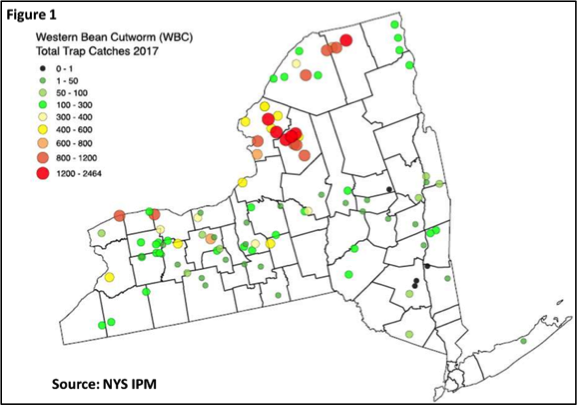Joe Lawrence, Gary Bergstrom, Jaime Cummings, Elson Shields, Ken Wise, Mike Hunter
Mold and mycotoxin development in corn ears and the resulting corn silage continues to be a major concern for dairy producers. Mycotoxins can result in a range of problems for livestock throughout the year as they are ingested with the feed. The presence of mold does not always have a strong correlation to mycotoxin development but it does present the chance for incidence to occur.
A number of factors influence the prevalence of molds from year to year. Conducive weather conditions for mold and mycotoxin development are outside the control of management options. But hybrid characteristics and physical damage to the ears can be managed through the selection of hybrids and pest resistance traits in the hybrids.
The presence of Western Bean Cutworm (WBC) in NY corn fields continues to expand as shown in the WBC Pheromone Trap Network coordinated by the NYS IPM program, though the insect’s apparent population varies significantly across the state (Figure 1).
Where WBC populations are high, the corresponding ear damage from WBC feeding can leave wounded corn ears more susceptible to pathogen development, but a clear relationship between ear damage and mycotoxin development has not been documented. A number of mold species may develop on corn ears and a relatively few of these produce mycotoxins. Principal concern in New York is with the mycotoxins deoxynivalenol (DON or vomitoxin) and zearalenone, both produced by the fungus Fusarium graminearum.
While WBC damage to corn ears can be significant and may have detrimental effects on corn grain yield and quality, the economic impact on corn silage is less understood. For corn silage growers, understanding whether or not this pest significantly impacts the yield or quality of the forage is critical to their decision making for managing this pest.
Since the Cry1F protein, which has most commonly been utilized for protection against numerous corn insect pests, has been found to be ineffective against WBC, producers are left with limited management options. Currently the Vip3A trait in select corn hybrids in combination with a scout and spray program is the best option for WBC management in areas where the pest is prevalent.
The Commercial Corn Silage Testing program conducted by Cornell University in collaboration with the University of Vermont and the Northeast dairy industry offers a good opportunity to evaluate numerous hybrids for ear damage from WBC and mycotoxins. This was done in 2017 with support from both the New York Corn Growers Association and the Northern New York Agricultural Development Program.
In 2017, 49 hybrids were selected and planted in replicated plots at two locations in NY (Aurora and Madrid). Each plot was scouted prior to harvest for WBC feeding damage to the ears. Composite samples, of whole plant silage, for each hybrid were taken at harvest and submitted to the Dairy One forage laboratory for a mycotoxin screening package which included aflatoxins B1, B2, G1, G2, vomitoxin, 3-acetyl DON, 15-acetyl DON, zearalenone, and T2 toxin.
The results of the WBC and mycotoxin screening project revealed large differences in the number of hybrids damaged by WBC, but surprisingly few hybrids tested positive for measurable mycotoxins (Table 1).
The most prevalent species of mycotoxin-producing mold found in the screening was Fusarium graminearum which can also infect corn ears through the silk channels at the time of pollination during favorable weather conditions and result in contamination of the grain and silage with the mycotoxins DON, 3-ADON, 15-ADON, or zearalenone. A review of the 2017 weather data at both trial sites showed wet conditions conducive to this type of infection. As expected for New York, no aflatoxins were detected.
While there are numerous ways in which molds can establish themselves in forages, this study reflects a common challenge researchers face while attempting to document the conditions where mycotoxin development is likely. Recognizing that results are specific to the growing season experienced in 2017, which was conducive for silk channel infections. A different relationship between WBC damage and mycotoxin development may be found during a growing season less conducive to silk channel infections. These results from one year of data do not provide strong evidence that WBC damage is a significant concern for corn silage growers who are worried about mycotoxins in their silage. Multiyear studies, including years of varying weather conditions, are required for further evaluating these risks and providing recommendations. It is also important to note that these results do not reflect what may occur in corn harvested for grain as the time between silage harvest and grain harvest offers additional opportunities for infection and growth.
Additionally, there was no correlation between crop yield or starch content with WBC damage in this study. Growers should continue to scout for this pest and weigh the cost of control with the potential for damage.
An article addressing integrated pest management (IPM) practices for WBC has been generated by the NYS IPM team.
Integrated Pest Management for Western Bean Cutworm (Richia albicosta), https://blogs.cornell.edu/ipmwpr/








